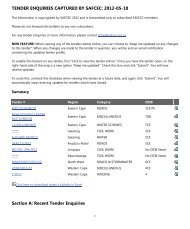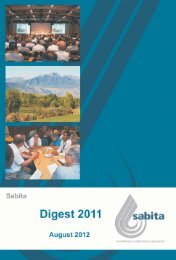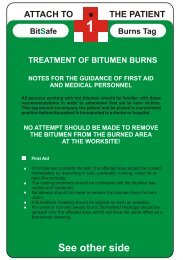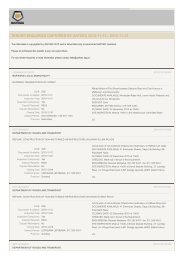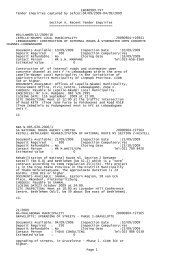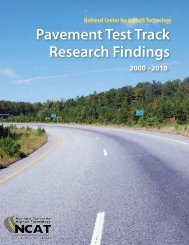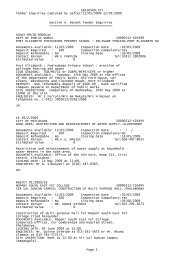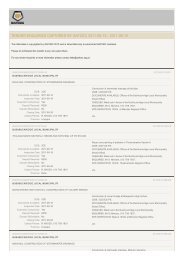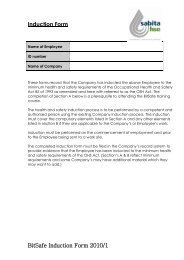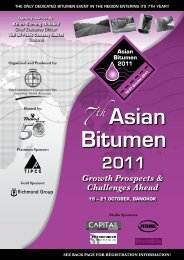DIGEST 2006 - Sabita
DIGEST 2006 - Sabita
DIGEST 2006 - Sabita
You also want an ePaper? Increase the reach of your titles
YUMPU automatically turns print PDFs into web optimized ePapers that Google loves.
Properties Tar Prime Cutback bitumen<br />
prime<br />
Invert bitumen<br />
emulsion<br />
Water content 0% 0% < 20%<br />
Solvent type Polar Non-polar Non-polar<br />
Solvent Creosote-like Paraffin-like Paraffin-like<br />
Viscosity Low Highest Lower than<br />
cutback bitumen<br />
Table 1: Tar vs bitumen primes<br />
construction. Placing hot mix<br />
asphalt or a seal on a prime that<br />
has not penetrated into the base<br />
substrate raises the probability of<br />
problems appearing later during<br />
the life of the surfacing.<br />
Penetration<br />
The penetration and drying<br />
problems with primes are worse in<br />
winter and this led the technical<br />
team at Tosas to investigate<br />
various ways to overcome these<br />
problems. The fact that the<br />
viscosity of bituminous products<br />
increases at lower temperatures<br />
prompted the Tosas team to<br />
investigate ways of decreasing<br />
viscosity. The alternatives were:<br />
• Increase the percentage of<br />
cutter to reduce the viscosity:<br />
This is standard practice and<br />
all suppliers can make the<br />
alterations, formulating a<br />
non-SABS 308 product,<br />
(unfortunately at a cost to<br />
the client). For example: MC<br />
30 + 10% additional paraffin;<br />
• Change the solvent type:<br />
(This was also investigated<br />
and may prove to be a<br />
longer-term solution if the<br />
specifications for cutback<br />
products are amended);<br />
• Emulsify the cutback bitumen<br />
in water: i.e. normal<br />
‘oil-in-water’ as opposed to<br />
invert emulsion where the<br />
water is the discontinuous<br />
phase. (Although the<br />
viscosity is reduced, one can<br />
be fooled by false penetration<br />
– although the water and<br />
some of the solvent<br />
penetrate, the bitumen<br />
droplets are unable to do so,<br />
and coagulate on top to form<br />
a skin. A high concentration<br />
of soap is also required to<br />
emulsify the product, which<br />
has a water content of<br />
between 40 and 50%. This<br />
large proportion of free water<br />
reduces the net binder<br />
content dramatically, and the<br />
contractor would be better off<br />
spraying bitumen primes at<br />
30-40% below specified<br />
application for the same<br />
effect.);<br />
• Look at the effect of<br />
temperature.<br />
Temperature<br />
Everyone knows that it is colder in<br />
winter and warmer in summer, air<br />
temperatures are lower than the<br />
road temperatures as it is warmer<br />
in the direct sun than in the<br />
shade.<br />
The clever philosopher who once<br />
said: “You do not know that which<br />
151



